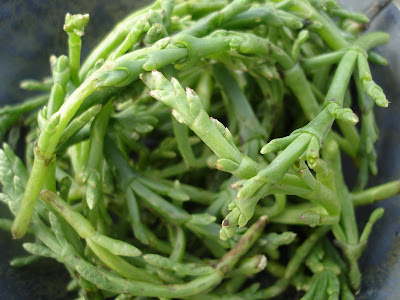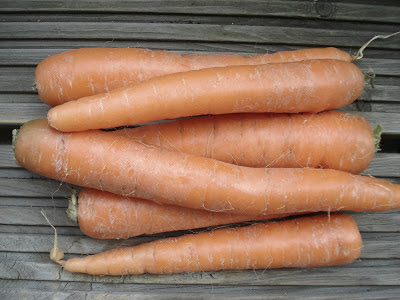Salty cravings
'Tis the season for West Coast samphires! If you've ever eaten salt-marsh lamb, and wondered how it got its salty flavour: these are the answer. The pine-needle-shaped plant grows in coastal marshes, where its feet are constantly bathed in seawater. In fact, when eaten raw, samphire taste just like the sea: mouth-dryingly salty with a final note of bitterness. The briefest cooking will rid this seaside weed of any bitter traces, and some of its salt.
As a vegetable, samphire are of little interest since they are too salty to eat on their own. However, their brininess makes them an ideal candidate for instant pickles, and can serve as a seasonal replacement for imported capers. Trimmed of their woody ends, samphire should be briefly blanched (5-10 seconds in boiling water) before being marinated in a simple vinegar or lemon dressing (half and half vinegar/lemon juice and oil). They will keep for at least a week in the dressing. Roughly chop, and use in any recipe calling for capers.
Samphire (salicornes in French, which sounds like 'salty horns', but apparently is of Arabic origin) are also known as sea asparagus: their textures are very similar, and they happen to make an ideal match. Sauté some trimmed asparagus in butter; when they are almost done (or use leftover spears), throw in a small handful of cleaned, fresh samphire (or pickled). Stir until heated through. Season with pepper (but no salt!), and add a splash of lemon juice.
Being a coastal vegetable, sea bean (another of its many monikers, along with glasswort) is often paired with sea creatures. Chopped into a butter sauce, it is lovely over any grilled fish, but it is truly divine with lobster (which happens to be in season!) Some oyster bars use samphire as a garnish on their seafood platter; if you ever happen to luck out, do not treat this wild food like any old piece of curly parsley: snap off a bit, spritz some lemon and eat it with your oyster. It will greatly enhance the marine intensity of the shellfish.
Samphire are most often found fresh, when in season or pickled in jars, at fishmongers, or at the market, if yours happens to have a forager's stand. East coasters will have their own harvest from the end of June up until September.
Bon app'!



Comments
Post a Comment